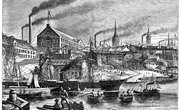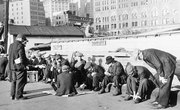What was the Impact of Light Bulbs on Society?
The invention of the incandescent light bulb is often seen as a major historical American milestone. This landmark product, first appearing in the late 1800s, helped revolutionize human society and spur further advancements. The societal impact of the light bulb is multi-tiered, but it can most succinctly be expressed in terms of work, leisure, and safety.
Thomas Edison’s invention of the electric light helped inspire inventors everywhere in the 19th century to create new, revolutionary products to help American society be better off. As a shift from oil lamps and gas lighting, the incandescent lamp or light bulb led to many further adaptations of light products, like LED bulbs and LED lighting in the future, less energy usage, educational tactics on lighting lumens and many more new technologies. This new artificial light source allowed compact fluorescent light bulbs to be made with carbon filaments and light-emitting diodes.
Edison’s light bulb allowed a whole Department of Energy to be created throughout the country as well, with uses of electric generators, electric light bulbs, halogen bulbs, vacuum pumps, fluorescent lamps, phonographs, and whole lighting systems to be used into the future. These original bulbs were especially important around the time of the World Wars when they were needed as sources of light in power plants and factories that needed general electric to operate and create war products.
Lighting technologies have surely changed since this original invention and history of the light bulb, especially as more new and improved products make their way into society like in New York City and other populated areas. Lights even have different categorizations for color needs, like swan, tesla and tungsten.
The invention of the light bulb was just one step in a multitude of changes that happened as a result of the light bulbs creation. While this invention led to energy-efficient lighting tactics in the time, it also led to major changes to society within the Industrial Revolution.
Working Hours
One of the most notable impacts of the light bulb was that it made longer work hours possible. While a longer work week often meant abuse of the working class, increased nighttime productivity helped spur industrial advancements. Workday activities were also changed within these new hours, as workers had more time to complete tasks on the job.
Workplace Safety
Increased luminescence in the workplace helped make it easier for laborers to see potential workplace hazards. While safety standards were admittedly poor in the late 1800s, the light bulb did help make moderate improvements.
Home Safety
Candles and oil-based lamps were dangerous fire hazards, leading to many yearly deaths. The light bulb made for a safer nighttime home environment. This invention allowed for lifespans to be increased due to the reduction of home hazards and emissions within previous light sources.
Leisure Hours
While many people found themselves working later, they also found that increased nighttime luminosity made it possible to enjoy leisure activities late into the night.
Leisure Activities
Prior to the light bulb, electricity was mainly used in industrial centers. With the light bulb, many homes installed electric outlets; the light bulb made it possible for electric radios, televisions and eventually video game systems to enter the home.
Related Articles
Writer Bio
<!--StartFragment-->I am a current senior studying at the University of Missouri - Columbia with a major in Journalism and a minor in Sociology. I have interests in photojournalism, documentary journalism and design fields. <!--EndFragment--><!--EndFragment--><!--EndFragment-->









